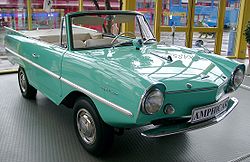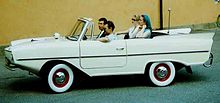Amphicar 770
| Amphicar | |
|---|---|
|
Amphicar as a museum exhibit
|
|
| 770 | |
| Production period: | 1961-1968 |
| Class : | Middle class |
| Body versions : | Cabriolet |
| Engines: |
Otto engine : 1.2 liters (28 kW) |
| Length: | 4330 mm |
| Width: | 1565 mm |
| Height: | 1520 mm |
| Wheelbase : | 2100 mm |
| Empty weight : | 1050 kg |
The Amphicar 770 is a floatable car from the Amphicar brand . The designer of the amphibious vehicle was Hans Trippel . The Amphicar 770 is the first civil amphibious vehicle.
description
The car has a self-supporting all-steel body reinforced with tubular side members, the lower part of which is formed as a closed tub made of 1.5 mm thick sheet metal. All parts are firmly welded together. The doors are also locked from the inside with a second handle for travel in the water and thus pressed more tightly against the door seals to prevent water from entering. In the engine compartment, the vehicle has a bilge pump as standard to pump out water that can enter the axle shafts, for example. It is also equipped with a position light (red / green) and a horn on the front cover. When driving in water, a white position light on a short mast had to be attached to the trunk lid. The spare wheel is in the front under the trunk, and the fuel tank is above the front axle. The convertible offers space for four people.
All wheels are individually suspended, have coil springs with hydraulic shock absorbers and hydraulically operated drum brakes (mechanical handbrake). The rear wheels are guided on drawn longitudinal swing arms, at the front the drawn swing arm is combined with a trailing arm in the manner of a crank arm axle , which keeps the caster constant.
The front wheels are used to steer both on the road and in the water.
The four-cylinder in - line engine comes from the British Triumph Herald 1200. The four-stroke engine develops 38 hp (28 kW) from just under 1.2 liters of displacement. The power is transmitted via a single-plate dry clutch to the transmission, which is located in front of the engine in the direction of travel. It is a fully synchronized four-speed special gearbox from Hermes in Wuppertal with an additional 3: 1 ratio reversing gear with only one forward and reverse gear (and idling) for driving two plastic propellers . In the water, the driver shifts the road transmission to neutral and activates the propellers or ship's propellers with a second shift lever.
The maintenance effort for the Amphicar was great; because after every trip on the water 13 grease nipples had to be supplied with grease. To do this, the vehicle had to be jacked up and the rear seat bench removed.
On the road, the Amphicar reached a top speed of approx. 120 km / h, in the water up to 6.5 knots or 12 km / h. The Amphicar was surprisingly seaworthy, even during a test drive in wind force 8 (62–74 km / h) in the Baltic Sea it could not be capsized .
Technical specifications
| Parameters | Data |
|---|---|
| Engine: | 4-cylinder four-stroke in-line engine (lengthways behind the rear axle) |
| Displacement : | 1147 cc |
| Bore × stroke: | 69.3 x 76 mm |
| Compression: | 1: 8.0 |
| Power: | 28 kW (38 PS) at 4750 rpm |
| Max. Torque: | 80 Nm at 2500 rpm |
| Valve control: | underlying camshaft, tappets, bumpers and rocker arms |
| Cooling: | Water cooling |
| Transmission: | fully synchronized four-speed gearbox (road) and reverse gear with one forward and one reverse gear for boat operation; two gear levers |
| Front suspension: | drawn longitudinal swing arm and trailing arm |
| Rear suspension: | drawn longitudinal swing arm |
| Suspension: | Coil springs with hydraulic shock absorbers combined |
| Brakes front and rear: | hydraulically operated drum brakes, Ø 230 mm (hand brake mechanically acting on the rear wheels) |
| Body: | Self-supporting all-steel body, reinforced by tubular side members |
| Dimensions (length × width × height): | 4330 × 1565 × 1520 mm |
| Ground clearance: | 253 mm |
| Wheelbase : | 2100 mm |
| Track width front / rear: | 1212 mm / 1260 mm |
| Wheel size: | 6.40-13 |
| Empty weight (without driver): | 1050 kg |
| Maximum weight allowed: | 1350 kg |
| Top speed: | Road: 120 km / h - water: 12 km / h |
| Fuel consumption on the road: | approx. 9 l / 100 km |
| Fuel consumption on the water: | 2.3 l / hour at 5 km / h, 10 l / hour at 10 km / h |
Technical data according to Oldtimer Markt 10/2010 and www.deutsche-automobile.de
Museum presentation
- Auto and Technology Museum Sinsheim
- PS storage in Einbeck
- Autoworld in Brussels
driving licence
The operation of the Amphicar on the water in Germany requires a sports boat license .
Others
On September 16, 1962, four Englishmen in two vehicles, one of which later had to be towed by the other, crossed the English Channel from Dover to Calais in 7 hours and 20 minutes.
The Hamburg police had an Amphicar in use.
In the 1980s, the show Do you understand was fun? produced a film with a hidden camera in which Reinhard Mey was picked up in an Amphicar for an appearance "because of the beautiful weather". The car suddenly drove into a river without warning. Reinhard Mey was not frightened, just laughed - he knew the vehicle.
In episode 10 of the 4th season of the 2013 program “Fast N'Loud”, an Amphicar is overhauled and sold. Vehicle is driven and swims in a small lake.
In season 11, episode 7, an Amphicar is also being restored by DMAX's “ used car professionals ” .
Perfectly restored vehicles sell for up to US $ 80,000, a new transmission alone costs $ 15,000.
gallery
literature
- Harald H. Linz, Halwart Schrader : The International Automobile Encyclopedia . United Soft Media Verlag, Munich 2008, ISBN 978-3-8032-9876-8 , chapter Amphicar.
- George Nick Georgano (Editor-in-Chief): The Beaulieu Encyclopedia of the Automobile. Volume 1: A – F. Fitzroy Dearborn Publishers, Chicago 2001, ISBN 1-57958-293-1 , p. 56. (English)
- Hasso Erb: floating car. Cars & trucks. Motorbuch-Verlag, Stuttgart 1988, ISBN 3-613-01165-4 .
- Werner Oswald: German cars. Volume 4: 1945-1990. Audi, BMW, Mercedes, Porsche, and others. Motorbuch-Verlag, Stuttgart 2001, ISBN 3-613-02131-5 , pp. 484-485.
- Christian Wüst: Enjoy aquaplaning . In: Der Spiegel . No. 23 , 2007, p. 170 ( online ).
Web links
- The Amphicar . In: Spiegel Online - Auto
- Amphicar Club Berlin eV
- private website with lots of information (English)
Individual evidence
- ↑ http://www.amphicar.net/minnow_old/Assemblies/FrontAxels.JPG Exploded view of the front axle
- ↑ Amphicar - a buoyant roadster . In: Motor vehicle technology 07/1961, p. 295.
- ↑ Achim Schmidt, Kai Schwarz: The vehicles of the police . Ed .: Sammüller Kreativ GmbH. Edition XXL GmbH, Fränkisch-Crumbach 2006, ISBN 978-3-89736-328-1 , p. 25 .
- ↑ youtube.com: Kurt Felix & Reinhard Met ... at 3:00
- ↑ Shelby Rent-A-Racer Resto, Part 2 + Amphicar. Retrieved October 27, 2019 .
- ↑ The used car professionals: The Amphicar. DMAX, accessed on October 27, 2019 (German, (English, original)).










